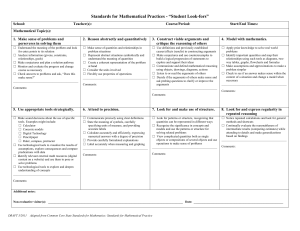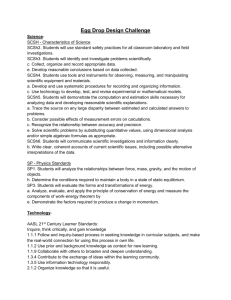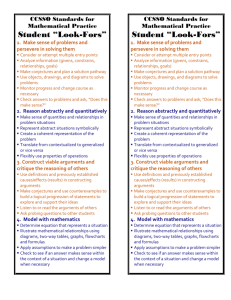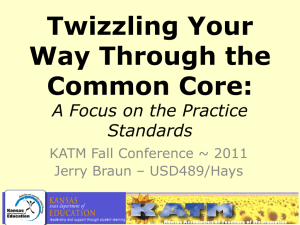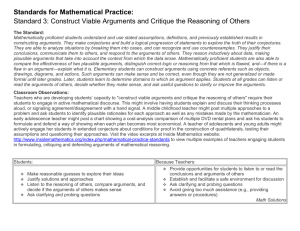Mathematical Practice - Lewiston Independent School District #1
advertisement
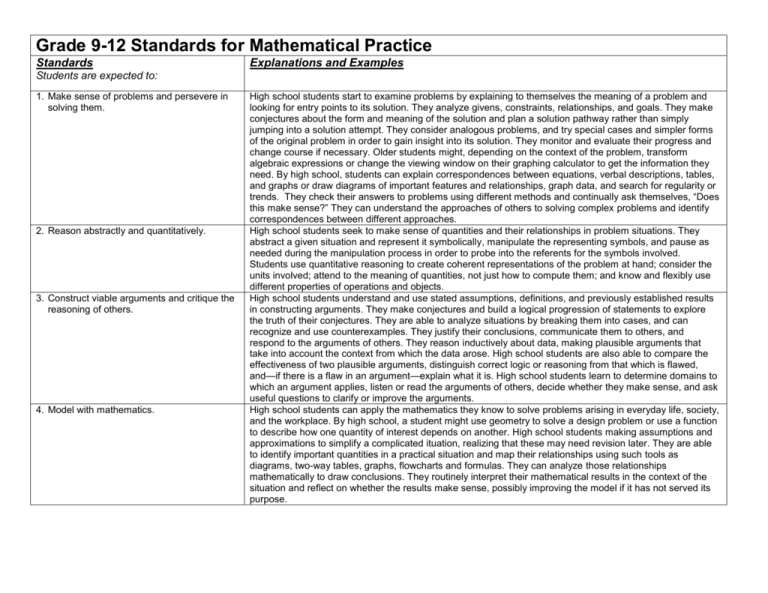
Grade 9-12 Standards for Mathematical Practice Standards Explanations and Examples Students are expected to: 1. Make sense of problems and persevere in solving them. 2. Reason abstractly and quantitatively. 3. Construct viable arguments and critique the reasoning of others. 4. Model with mathematics. High school students start to examine problems by explaining to themselves the meaning of a problem and looking for entry points to its solution. They analyze givens, constraints, relationships, and goals. They make conjectures about the form and meaning of the solution and plan a solution pathway rather than simply jumping into a solution attempt. They consider analogous problems, and try special cases and simpler forms of the original problem in order to gain insight into its solution. They monitor and evaluate their progress and change course if necessary. Older students might, depending on the context of the problem, transform algebraic expressions or change the viewing window on their graphing calculator to get the information they need. By high school, students can explain correspondences between equations, verbal descriptions, tables, and graphs or draw diagrams of important features and relationships, graph data, and search for regularity or trends. They check their answers to problems using different methods and continually ask themselves, “Does this make sense?” They can understand the approaches of others to solving complex problems and identify correspondences between different approaches. High school students seek to make sense of quantities and their relationships in problem situations. They abstract a given situation and represent it symbolically, manipulate the representing symbols, and pause as needed during the manipulation process in order to probe into the referents for the symbols involved. Students use quantitative reasoning to create coherent representations of the problem at hand; consider the units involved; attend to the meaning of quantities, not just how to compute them; and know and flexibly use different properties of operations and objects. High school students understand and use stated assumptions, definitions, and previously established results in constructing arguments. They make conjectures and build a logical progression of statements to explore the truth of their conjectures. They are able to analyze situations by breaking them into cases, and can recognize and use counterexamples. They justify their conclusions, communicate them to others, and respond to the arguments of others. They reason inductively about data, making plausible arguments that take into account the context from which the data arose. High school students are also able to compare the effectiveness of two plausible arguments, distinguish correct logic or reasoning from that which is flawed, and—if there is a flaw in an argument—explain what it is. High school students learn to determine domains to which an argument applies, listen or read the arguments of others, decide whether they make sense, and ask useful questions to clarify or improve the arguments. High school students can apply the mathematics they know to solve problems arising in everyday life, society, and the workplace. By high school, a student might use geometry to solve a design problem or use a function to describe how one quantity of interest depends on another. High school students making assumptions and approximations to simplify a complicated ituation, realizing that these may need revision later. They are able to identify important quantities in a practical situation and map their relationships using such tools as diagrams, two-way tables, graphs, flowcharts and formulas. They can analyze those relationships mathematically to draw conclusions. They routinely interpret their mathematical results in the context of the situation and reflect on whether the results make sense, possibly improving the model if it has not served its purpose. Grade 9-12 Standards for Mathematical Practice Standards Explanations and Examples Students are expected to: 5. Use appropriate tools strategically. 6. Attend to precision. 7. Look for and make use of structure. 8. Look for and express regularity in repeated reasoning. High school students consider the available tools when solving a mathematical problem. These tools might include pencil and paper, concrete models, a ruler, a protractor, a calculator, a spreadsheet, a computer algebra system, a statistical package, or dynamic geometry software. High school students should be sufficiently familiar with tools appropriate for their grade or course to make sound decisions about when each of these tools might be helpful, recognizing both the insight to be gained and their limitations. For example, high school students analyze graphs of functions and solutions generated using a graphing calculator. They detect possible errors by strategically using estimation and other mathematical knowledge. When making mathematical models, they know that technology can enable them to visualize the results of varying assumptions, explore consequences, and compare predictions with data. They are able to identify relevant external mathematical resources, such as digital content located on a website, and use them to pose or solve problems. They are able to use technological tools to explore and deepen their understanding of concepts. High school students try to communicate precisely to others by using clear definitions in discussion with others and in their own reasoning. They state the meaning of the symbols they choose, specifying units of measure, and labeling axes to clarify the correspondence with quantities in a problem. They calculate accurately and efficiently, express numerical answers with a degree of precision appropriate for the problem context. By the time they reach high school they have learned to examine claims and make explicit use of definitions. By high school, students look closely to discern a pattern or structure. In the expression x2 + 9x + 14, older students can see the 14 as 2 × 7 and the 9 as 2 + 7. They recognize the significance of an existing line in a geometric figure and can use the strategy of drawing an auxiliary line for solving problems. They also can step back for an overview and shift perspective. They can see complicated things, such as some algebraic expressions, as single objects or as being composed of several objects. For example, they can see 5 – 3(x – y)2 as 5 minus a positive number times a square and use that to realize that its value cannot be more than 5 for any real numbers x and y. High school students use these patterns to create equivalent expressions, factor and solve equations, and compose functions, and transform figures. High school students notice if calculations are repeated, and look both for general methods and for shortcuts. Noticing the regularity in the way terms cancel when expanding (x – 1)(x + 1), (x – 1)(x2 + x + 1), and (x – 1)(x3 + x2 + x + 1) might lead them to the general formula for the sum of a geometric series. As they work to solve a problem, derive formulas or make generalizations, high school students maintain oversight of the process, while attending to the details. They continually evaluate the reasonableness of their intermediate results.
